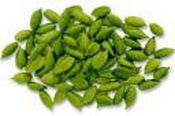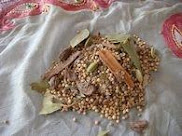
The Orange region has a lovely climate; very warm summers with low humidity and cool nights, cold winters with relatively few really cold days and most importantly, good rain, unlike much of the rest of Australia. A great climate to produce fine wines and grow fruit and vegetables (One of our neighbours established the first vineyard in the district in 1983). That is unless you live on a sheep station on top of a mountain (it’s a high tableland really - 750m above sea level – but it feels like a mountain) where strong winds from every direction batter your newly planted trees, flower beds and horror of horrors, your lovely, organic vegetable garden. Hot westerly's and north westerly’s can singe even the most robust of plants in the summer and the easterly’s (which can go on night and day for 7 days in a row at any time of the year) flatten everything in their path and virtually blow the roof off your house. Ah well, the views are absolutely beautiful…..
 We allowed ourselves to be seduced by the views, knowing this would be a challenging place to establish the vegetable garden I’ve been thinking about for a few years now. The whole venture has been a challenge really. We bought the 8 acre bare parcel of land, a former sheep station about 280K west of Sydney and 10K out of the city of Orange, in a place called Windera, in late 2005. Bare only in that it didn’t have a single tree, it was in fact covered with pasture grasses. Grasses that can grow to about 6 ft tall (and did), weeds like gigantic blackberry shrubs that are impossible to eradicate and lots and lots of rocks both small and large. My husband reckons some of the big ones go from here right through to China. They make getting a slasher in impossible, so much of the grass has to be slashed by hand until we clear the rocks.
We allowed ourselves to be seduced by the views, knowing this would be a challenging place to establish the vegetable garden I’ve been thinking about for a few years now. The whole venture has been a challenge really. We bought the 8 acre bare parcel of land, a former sheep station about 280K west of Sydney and 10K out of the city of Orange, in a place called Windera, in late 2005. Bare only in that it didn’t have a single tree, it was in fact covered with pasture grasses. Grasses that can grow to about 6 ft tall (and did), weeds like gigantic blackberry shrubs that are impossible to eradicate and lots and lots of rocks both small and large. My husband reckons some of the big ones go from here right through to China. They make getting a slasher in impossible, so much of the grass has to be slashed by hand until we clear the rocks. 
We fenced off the lower 5 acres and placed there some living lawnmowers and fertiliser producers (cattle), and through much dedication and even more hard labour we finally managed to get a small one bed-room dwelling built on the top block in February 2008. We had about 300 native trees and 20 fruit trees planted the year before and the cottage will serve as a base, a week or so on, 10 days or so off (we are still living and working in Sydney) from where we can plant more trees, plan and create the gardens, and supervise the building of the main house. We christen the place ‘Mount Sugarloaf’ and look forward to the next few years dodging the brown snakes, knee deep in compost and manure. There have been many trials and tribulations but it has been worth it. Just look at these beautiful beans.

Blue Lake, King Purple and Rattlesnake. Some mythical beings out of Harry Potter? No, Phaseolus Vulgaris - beans! Beans with purple pods, beans with green pods flecked with purple and beans with plain green pods. These are few of the many heirloom varieties that are (thankfully) readily available from seed saver associations and various other organisations worldwide.
Heirloom vegetables are our inheritance; selected and saved by our ancestors, sometimes over hundreds even thousands of years, they offer some of the best tasting, best yielding and disease resistant varieties. These open pollinated heirloom varieties are reliable, productive and easy to grow, unlike modern hybrids and genetically modified crops bred for transportability and storage, not flavour, goodness and continuity.
Beans both dried and fresh, are brimming with nutrients. An excellent source of protein they are also packed with vitamin C, vitamin K, vitamin A, manganese, folate, iron and many other minerals as well as omega-3 fatty acids and fibre.
I grew these three varieties of beans (that all turn green when cooked), along with dozens of other organic and heirloom vegetables and fruits, last season at Mt. Sugarloaf. They were easy to grow, incredibly resilient to the harsh conditions, and wonderfully productive over a many weeks. They were also very tasty.
These delicious beans have been in such abundant supply I have been using them in everything - pastas, stir fries, steamed with roasts and barbecues and curries like this one. Yummy....
Spicy Fresh Bean Bhaji
This bhaji is delicious with yoghurt, roti or paratha and Indian pickles. It is also particularly good as a side dish with a lamb or goat curry.
Both French beans and runner beans would be just as good, but they do need to be very fresh and full of flavour. It is the succulence and sweetness of the beans that make this dish so lipsmacking good. If you don’t grow your own, buy fresh locally grown or organically grown beans.
Serves 4-6 Preparation and cooking time: 45 minutes
3 tbsp ghee or olive oil
2 small or 1 large onion, finely chopped
2 cloves garlic, finely chopped
1 small knob of ginger, finely chopped
2 green chillies (or to taste), finely chopped
1 tsp turmeric
500g green beans, topped, tailed and sliced into 1 cm pieces
1 tsp salt
½ tsp garam masala
Sauté the onion in the ghee or oil until starting to brown at the edges. Add the garlic and ginger and fry for a minute until aromatic.
Stir in the chillies, turmeric and salt and stir fry for a few seconds and add the beans. Stir the beans around in the pan until everything is well mixed.
Add a little water, stir and cover pan. Cook over low-medium heat for about 15-20 minutes, stirring regularly until the beans are tender. Add a little more water during this time if required to prevent the food sticking to the bottom of the pan.
Stir in the garam masala, cook for a few seconds more and serve.
There are many good reasons to grow your own food; flavour is only one of them. When the going gets tough, the tough get growing!
Spicy Fresh Bean Bhaji
This bhaji is delicious with yoghurt, roti or paratha and Indian pickles. It is also particularly good as a side dish with a lamb or goat curry.
Both French beans and runner beans would be just as good, but they do need to be very fresh and full of flavour. It is the succulence and sweetness of the beans that make this dish so lipsmacking good. If you don’t grow your own, buy fresh locally grown or organically grown beans.
Serves 4-6 Preparation and cooking time: 45 minutes
3 tbsp ghee or olive oil
2 small or 1 large onion, finely chopped
2 cloves garlic, finely chopped
1 small knob of ginger, finely chopped
2 green chillies (or to taste), finely chopped
1 tsp turmeric
500g green beans, topped, tailed and sliced into 1 cm pieces
1 tsp salt
½ tsp garam masala
Sauté the onion in the ghee or oil until starting to brown at the edges. Add the garlic and ginger and fry for a minute until aromatic.
Stir in the chillies, turmeric and salt and stir fry for a few seconds and add the beans. Stir the beans around in the pan until everything is well mixed.
Add a little water, stir and cover pan. Cook over low-medium heat for about 15-20 minutes, stirring regularly until the beans are tender. Add a little more water during this time if required to prevent the food sticking to the bottom of the pan.
Stir in the garam masala, cook for a few seconds more and serve.
There are many good reasons to grow your own food; flavour is only one of them. When the going gets tough, the tough get growing!











1 comments:
Fantastic!!!
Where have you been hiding? Where can I buy your book?
Post a Comment